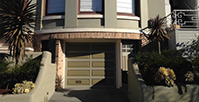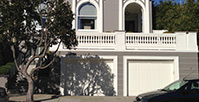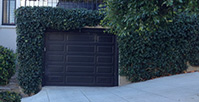Add A Garage has a great deal of experience in making multi-family residential buildings safer. In the next few years, some San Francisco building owners will be required to seismically upgrade their buildings to reduce the risk of "pancaking" in an earthquake.
Here is what you need to know.
Background.
San Francisco's Mandatory Soft Story Retrofit Ordinance is intended to mitigate a hazard in existing buildings, i.e., buildings having soft, weak or open front wall lines (a "soft-story condition), the first story has perimeter walls that have large openings for garage doors or windows, has few interior partitions, and/or is constructed of materials that have deteriorated over time.
There are approximately 4,300 wood-frame buildings in San Francisco that were built before January 1, 1978, having five or more dwelling units and three or more stories. At least 2,800 of these may have a weak-story condition or similar vulnerability. These vulnerable buildings can be found throughout the City, most notably in the Mission, Western Addition, Richmond, North Beach, and Marina neighborhoods. About 58,000 people live in the subset of 2,800 buildings with the largest perimeter wall openings. These buildings house close to 2,000 businesses that employ an estimated 7,000 people.
Buildings Subject to Program.
Building that have the following characteristics will be required to be undergo a "Soft-Story Retrofit":
- 3 or more stories.
- 5 or more units.
- Building permits that were applied for before 1/1/78
- Not been seismically strengthened.
Screening Form.
1. The owner must hire an architect or engineer to submit a "Screening Form" that includes:
A. All information required by the City.
B. Whether the building is exempt from the requirements.
C. If not exempt, the appropriate "Compliance Tier".
2. If the owner claims the building is exempt, the architect or engineer must also submit an "Evaluation Form" describing the seismic work done that satisfies the exemption and which includes the plans for the work.
Exceptions.
A building will not be required to undergo a Soft-Story Retrofit if:
A. It has been seismically strengthened to meet or exceed the standards of the SF Building Code within the past 15 years.
B. It has completed voluntary seismic strengthening under the voluntary soft-story seismic upgrade program the City implemented in April of 2010.
Compliance Tiers.
All buildings that are not exempt are classified by their size (by number of units), type and/or whether they are in a liquefaction zone, called "Compliance Tiers". Different time frames apply to buildings in different Compliance Tiers.
All buildings have 1 year plus 60 days from the operative date to submit the Screening Form to the City. Depending on the Compliance Tier, owners have between 2 and 5 years (2015 to 2018) to submit a permit application and between 4 and 7 years (2017 to 2020) to complete the work.
The building permit application must include only the work required for the Soft Story Retrofit and nothing else (except minor work) "unless such work is triggered by or integral to the seismic retrofit work". The permit that is issued with be for only that work.
Notice.
The City will give notice to all owners whose buildings it believes are within the scope of the Soft-Story Solutions within 60 days after the operative date of the Program. That will trigger the owners' obligation to submit the Screening Form. If they know their building is subject to the program but do not get notice, they still must complete the Screening Form. A list of all buildings subject to the Program will be listed on the Building Department's website.
Soft-Story Retrofit Requirements.
The Building Department will publish one or more bulletins to provide details of the technical requirements for Soft-Story Retrofit work. The requirements will most likely be derived from a number of building industry technical publications. Engineers expect that the requirements (and cost) will vary based on the building type, i.e., which "Compliance Tier" the building is in.
Cost of Work.
The Program states that "Seismic retrofits at the recommended level are likely to cost in the range of $60,000 to $130,000 per building for direct construction costs." However, until the City issues its technical requirements for the work, we cannot know how much the work will actually cost. Also, since owners have up to 7 years to do the work, market forces will play a role in the cost.
Conclusion.
Owners will have to do the Soft-Story Retrofit by 2020 at the latest. It makes sense to do it as soon as possible, if for no other reason than to reduce the risk of a building collapse well before the deadline. The more time that passes, the more expensive the work will probably be. Owners should consult a competent contractor with seismic experience to determine what needs to be done and how much it's likely to cost so they can decide how they wish to proceed.


